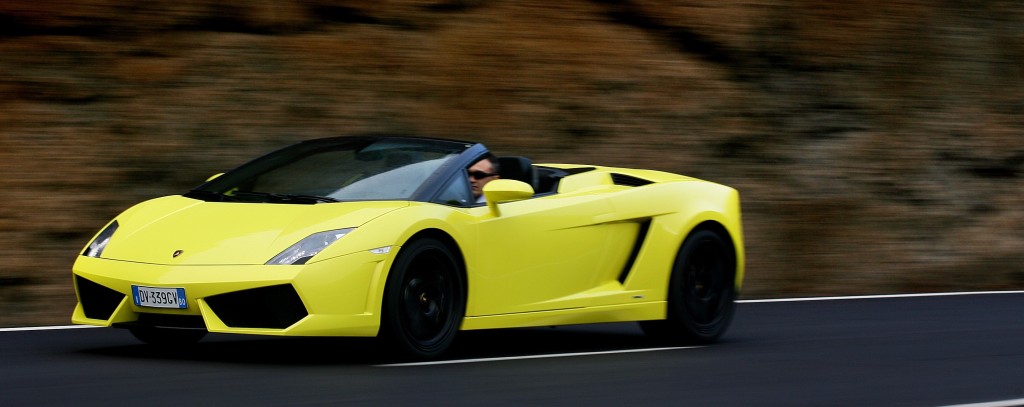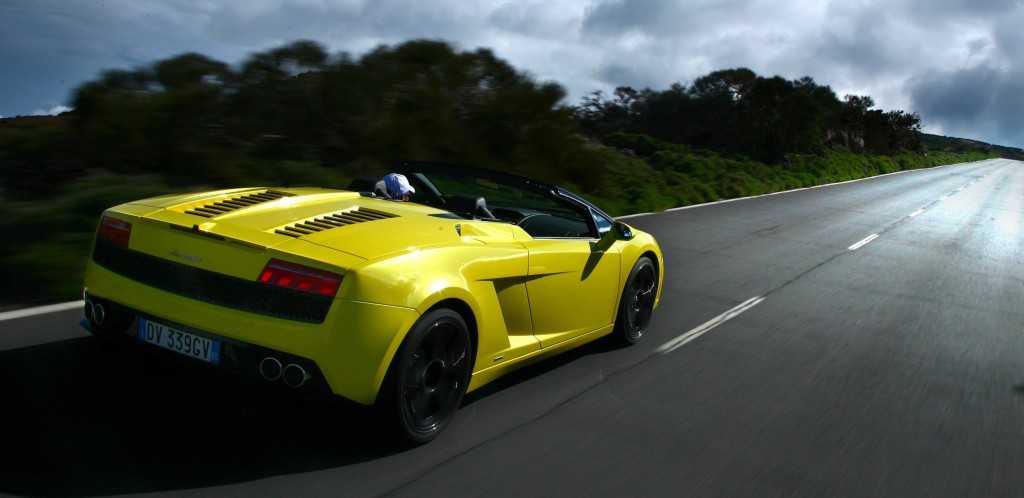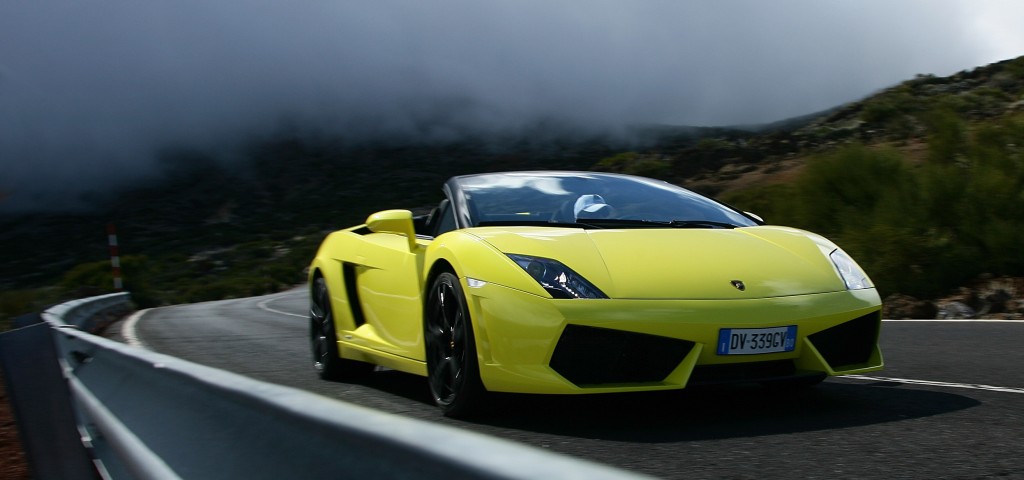First Drive: 2010 Lamborghini Gallardo LP 560-4 Spyder
[svgallery name=”10_lambo_Gallardo_Spyder_2″]
Story and photos by John LeBlanc
CANARY ISLANDS, Spain – Like the personalities of the charging bulls that its long line of super sports cars have been named after, Automobili Lamborghini S.p.A., has always appeared to be run on pure, unadulterated emotion.
Rational business sense, meh, not so much.
After founder Ferruccio Lamborghini sold out to Fiat in 1972, the Swiss Mimran brothers, Chrysler, and Indonesian investment group Megatech all have taken a crack at running the low-volume super sports car maker, each with varying degrees of financial success.
But Audi’s takeover of in 1998 — and the subsequent decision to move Stephan Winkelmann, a 46-year-old Italian-raised German to the helm of the company in 2005 — allowed the emotionally charged brand to be run like a real, rational business for the first time in its five-decade history. Despite having its most successful year ever (2,430 cars sold worldwide) in 2008, CEO and President Winkelmann expects 2009 to be a “challenging” year.
“The mortgage and financial crisis in the U.S. market has certainly hurt our sales there. We have lost a lot of customers that we never had before,” said Winkelmann candidly. While other automakers are canceling or postponing indefinitely new products, Lamborghini’s plan so to stay focused, stay profitable, stay on brand, and keep the new models coming.
Which leads us to this year’s new Lamborghini: the convertible version of its top-selling Gallardo.
A tough act to follow
The all-wheel drive, two-seat, mid-engine V10-powered Gallardo has been the best selling Lamborghini since the company added sports cars to its tractor-building business in 1963. Since its launch in 2003, more than 8,500 Gallardo Coupes and Spyders have rolled out of Lamborghini’s exclusive Italian factory in Sant’Agata near Bologna.
For 2010, the exotic automaker’s lineup still revolves around two cars, the larger and more powerful V12 Murciélago (recently updated to include the LP 670-4 SuperVeloce and the LP 650-4 Roadster) plus the “entry level” Gallardo, which makes up about three-quarters of the brand’s sales.After last year’s mid-cycle refresh of its $245,000 Gallardo LP 560-4, an update of the $272,700 Gallardo LP 560-4 convertible – or Spyder – was inevitable, like a good meal in Italy.
Just like the coupe … but bring sunscreen
When it comes to upgrades for the new 2010 Spyder, Lamborghini didn’t leave anything off the menu. This year’s soft-top version receives a more powerful engine, permanent all-wheel drive and the same aggressive styling changes as last year’s LP 560-4 Coupe.
What has been deliberately left behind is the Coupe’s permanent metal roof. But don’t think that has compromised any of the Spyder’s performance.
“Our customers get the same performance, whether it’s Coupe or Spyder,” said Lamborghini’s director of research and design, Maurizio Reggiani. And like the Coupe, in typical Lamborghini fashion, the new Gallardo Spyder outdoes its main rival, the V8-powered Ferrari F430 Spider with a 5.2-litre V10 that develops 560 horsepower and 368 lb.-ft. of torque.
The 2010 Gallardo Spyder’s aluminum body shell is lighter and stiffer than before, boasting a dry weight of only 1,550 kilos — 20 kg less than its predecessor. With 40 more horses than the previous Gallardo Spyder … you do the math. Okay, okay. Lamborghini did it for us: the Spyder takes just 4.0 seconds to sprint from zero to 100 km/h; it reaches 200 km/h in only 13.1 seconds and tops out at 324 km/h.
Styling from planet Lamborghini
The Gallardo Coupe is hardly a wallflower in the looks department. If you want to be conspicuous about your consumption, there’s not much out there in the $250,000-plus arena that gathers the local auto paparazzi better than extreme-looking Lamborghini. If anything – without the Coupe’s thick C-pillar – the Spyder’s wedge-of-cheese styling attracts even more attention.
As with the 2009 Gallardo Spyder, two switches located on the car’s centre console operate a fully lined fabric top — available in black, blue, grey and beige. The first operates the top. The second works the small rear window that can be raised and lowered. When the roof is retracted and the glass window upright, it acts as a wind deflector.
The rest of the Gallardo Spyder’s cockpit is identical to the Coupe. Despite its knee-high exterior height, the interior is relatively roomy for two. Taller drivers will notice that the front windshield header may block sight lines for traffic lights. And remember, pack light: the 110-litre luggage compartment at the front of the vehicle is pretty much all you get for storage space.
Exoticar driving made easy
Tenerife, the largest (2034.38 square kilometers) and most populated (886,033 inhabitants) of the seven Spanish Canary Islands is located just west of the northern tip of Africa. Lamborghini couldn’t have picked a more extreme location to offer the media first drives in its new suitably extreme drop-top super sports car. A day spent driving the narrow and twisty roads up and down Mount Teide, the highest point in the Atlantic Ocean, and the 13th highest mountain in Europe would test the mettle of the updated Spyder. Mount Teide also happens to be an active volcano (currently dormant) which last erupted in 1905.
As in the Coupe, mounting the V10 longitudinally behind the cabin resulted in near-perfect weight distribution: 43-per cent front and 57-per cent rear. Throw in permanent all-wheel drive, and high levels of grip are guaranteed for most public roads.
During the morning drive, climbing and winding up Mount Teide, the more powerful engine feels a bit soft at less than 2,500 rpm. But past 3,500 rpm – where flaps on the intake manifold and the camshaft’s timing adjusts – the V10’s shrill cry gets angrier and angrier, moving forward with real gusto. With a committed right foot, 8,000 rpm pops up on the tach in no time, accompanied by a booming exhaust and the sound of ten cylinders in orchestral harmony. Having the Spyder’s top down on a sunny day brings its occupants closer to the aural delights.
A six-speed manual transmission is offered as standard equipment. But Lamborghini says between 99- and 98-per cent of Gallardo owners chose the $11,890 “e-gear” sequential automatic. E-gear has three modes: fully automatic, a sports setting and “corsa,” which reduces shift times by 40-per cent. Improvements have made the semi-automatic gearbox smoother than when it was initially launched. Nevertheless, Lamborghini really needs a proper dual-clutch transmission to match the outstanding performance in the engine and chassis departments.
Despite the Spyder’s supercar capabilities, the smallest Lamborghini remains sufficiently civilized when toodling through heavier traffic on the afternoon run down the volcano. The ride isn’t too harsh, and there’s always all-wheel drive traction if you come across melting winter runoff crossing the road.
Baby Lambo ragtop has thin competition
In this rarefied class of car, the Gallardo LP 560-4 Spyder has few rivals. The Ferrari 430 Spider is the most obvious. But it is rear-wheel drive and has two fewer cylinders. And the recently introduced Aston Martin DBS Convertible V12 is more of a grand tourer than a super sports car. You could throw in Porsche’s all-wheel drive Turbo Cabriolet, but none of the above come with what may be the Lambo’s most valuable piece of standard equipment: its rock star image.
2010 Lamborghini Gallardo LP 560-4 Spyder
Base price: $272,700
Type of vehicle: AWD mid-engine roadster
Engine: 5.2L, 40-valve DOHC V10
Power/torque: 560 hp/398 lb.-ft.
Transmission: Six-speed manual (opt. Six-speed sequential manual)
0-100 km/h: 4.0 seconds
Fuel consumption: (city/hwy., est.): 21.0/10.0 L/100 km
Competition: Bentley Continental GTC Speed, Aston Martin DBS Volante, Ferrari F430 Spider, Porsche 911 Turbo Cabriolet
PREVIEW SUMMARY
PROS
– Extreme power, handling, styling, and now sunshine
– Aurally stimulating
– Civilized when it has to be
CONS
– Could use more low end torque
– Needs a dual-clutch transmission
– Not for shy folks








![[del.icio.us]](https://www.straight-six.com/wp-content/plugins/bookmarkify/delicious.png)
![[Digg]](https://www.straight-six.com/wp-content/plugins/bookmarkify/digg.png)
![[Facebook]](https://www.straight-six.com/wp-content/plugins/bookmarkify/facebook.png)
![[Google]](https://www.straight-six.com/wp-content/plugins/bookmarkify/google.png)
![[Reddit]](https://www.straight-six.com/wp-content/plugins/bookmarkify/reddit.png)
![[StumbleUpon]](https://www.straight-six.com/wp-content/plugins/bookmarkify/stumbleupon.png)
![[Twitter]](https://www.straight-six.com/wp-content/plugins/bookmarkify/twitter.png)
![[Email]](https://www.straight-six.com/wp-content/plugins/bookmarkify/email.png)